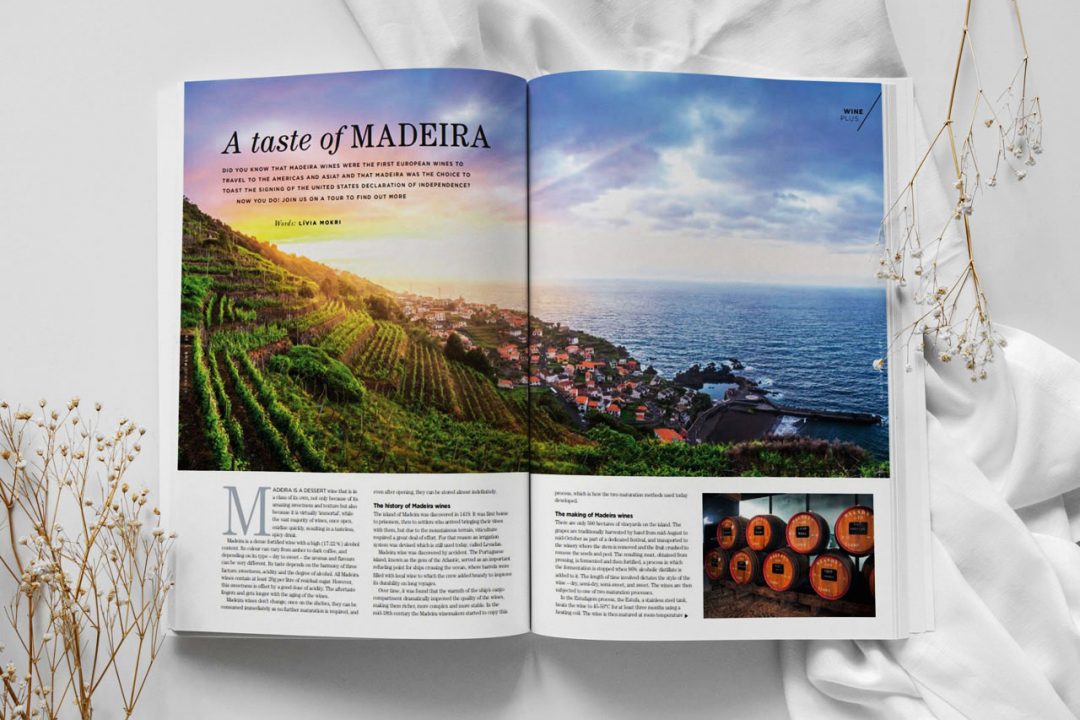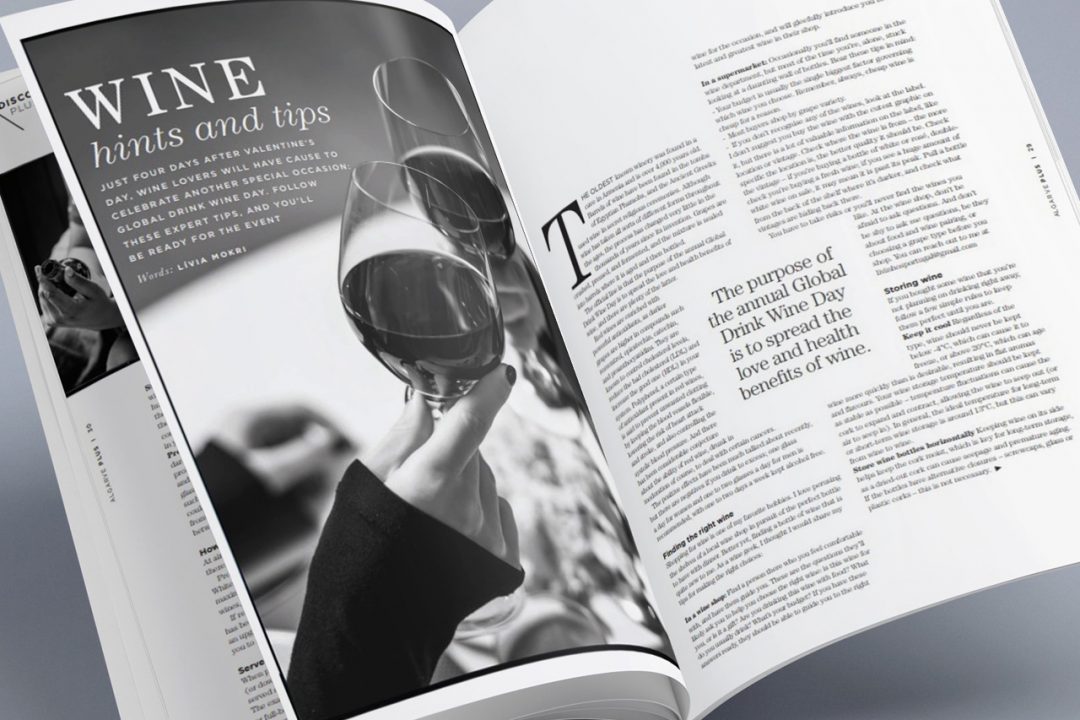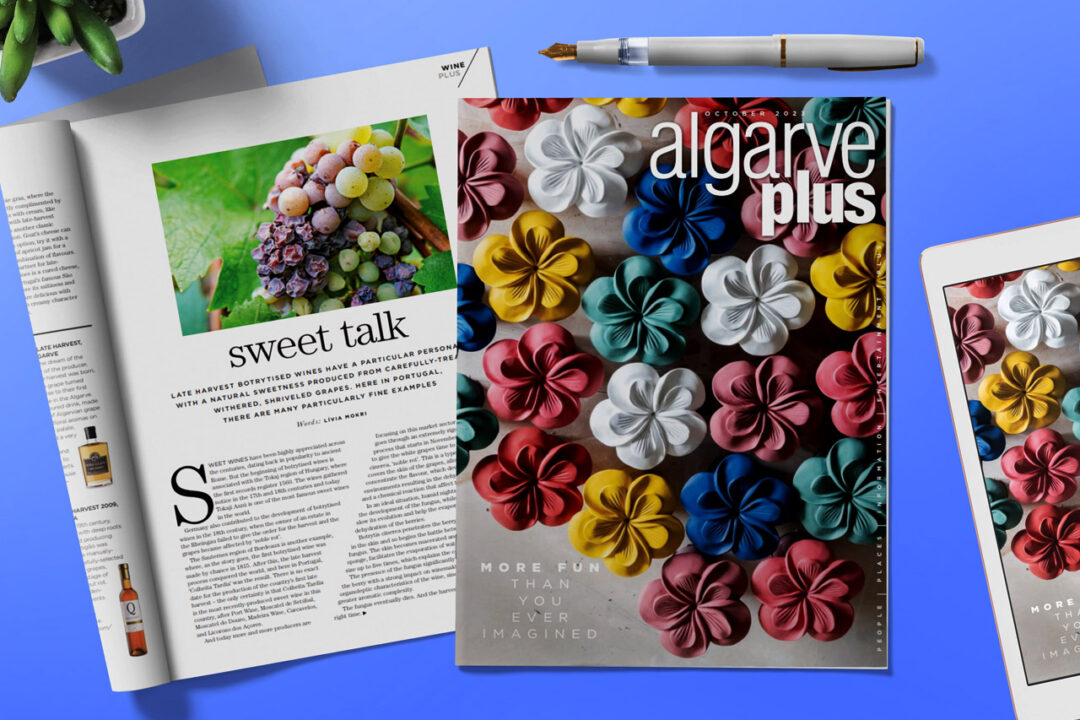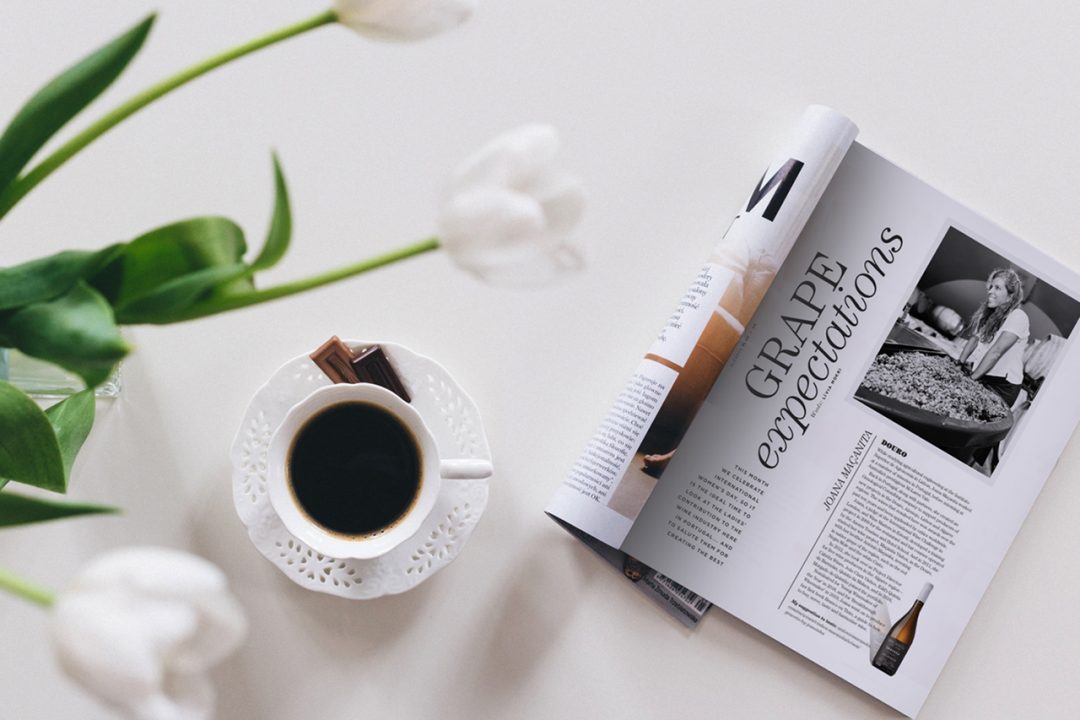A taste of Madeira – Did you know that Madeira wines were the first European wines to travel to the Americas and Asia?
And that Madeira was the choice to toast the signing of the United States Declaration of independence? Now you do!
I am happy to share that my new article in the Algarve Plus Magazine has been already published!
Join me on a tour to find out more. Head to my article in the August issue of the magazine below. You may read it online or download it for free as well.
And while you are reading the magazine, do not forget to taste a Madeira wine from Portugal!
The magazine is readable online or downloaded for free here.
Enjoy!
Or read here the whole article:
A taste of Madeira
Did you know that Madeira wines were the first European wines to travel to the Americas and Asia? And the fact that this is the wine with which was toasted for the United States Declaration of Independence?
For every wine enthusiast, the moment will come when you will face a fortified wine, be it Port wine, Sherry, Muscat, or just a Portuguese Madeira wine. And while many consider these wines too heavy or too sweet, their popularity is undoubtedly still unbroken.
This time let’s get acquainted with Madeira wine and let me give you a brief guide to this wine!
Madeira is a dessert wine that is unique not only because of its amazing sweetness and texture but also because it is virtually ‘immortal’. Around the world, the vast majority of wines in the open state oxidize quickly, resulting in a tasteless, spicy drink. Madeira wine, on the other hand, doesn’t change! Once they are on the shelves, they can be consumed immediately, no further maturation is required. Even after opening the bottle, we can be sure that it will not deteriorate, the most durable wines in the world, even after opening, can be stored almost indefinitely.
Madeira is a fortified, denser wine with a higher (17-22 %) alcohol content. Its color can vary from amber to darker coffee. Because it is made in several styles from dry to sweet, the shades of aromas and flavors can be very different. Its taste depends on the harmony of three factors: sweetness, acidity and the degree of alcohol. Irrespective of the degree of sweetness, all Madeira wines contain at least 20 g / L of residual sugar. However, this sweetness is offset by a good dose of acidity. The aftertaste is quite lingering and gets longer with the aging of the wines.
The legend of Madeira wines
The island of Madeira was discovered in 1419. They were first settled with prisoners, but soon settlers also arrived and took their vines with them. However, due to the mountainous terrain, viticulture required a great deal of effort. For example, that is why they built the irrigation system which is still used and famous today, the so-called ‘Levadas’.
However, the famous Madeira wine was discovered by accident. The Portuguese island, also known as the ‘gem of the Atlantic’, served as an important refueling point for ships crossing the ocean, filling their barrels with local wine at this time, to which they added brandy to improve its durability on long voyages. But over time, it was found that the warmth of the ship’s cargo compartment dramatically improved the quality of the wines, making them richer, more complex and more stable.
And in the mid-18th century, the Madeira winemakers started to make attempts to copy this process by land. This is how the two maturation methods used today developed. From then on, the growing market was supplied in increasing quantities as wine became more and more fashionable.
How these wines are made?
Only 500 hectares of vineyards are grown on the island. The grapes are traditionally harvested by hand from mid-August to mid-October as part of a majestic festival.
Then the grapes are transported to the winery where the stem is removed and the fruit is crushed to remove the seeds and peel as well. And then, the must, obtained from pressing is fermented and then fortified.
The fortification process consists of stopping the fermentation when 96% alcoholic distillate is added to the must. The date for stopping fermentation is according to the desired degree of sweetness of the wine. With this process, four types of wine can be produced: dry, semi-dry, semi-sweet, and sweet.
The wines can then be subjected to one of two maturation processes.
- Estufagem process
This process practically means intentional heating. Estufa is a stainless steel tank that heats the wine to 45-50 ° C for at least three months using a heating coil, mimicking the effects of wine on tropical cruises.
After heating, the wine is matured at room temperature for at least 90 days, allowing it to cool gradually, until the wine reaches the desired quality so that it can be bottled, which can never happen before 31 October of the second year after harvest.
Madeira wine is always the result of some kind of blending, so when it reaches the right quality, it is mixed with wine made from other grape varieties, usually the Tinta Negra grape variety. The year on the label indicates the age of the youngest wine in the blend.
- Canteiro process
The process takes its name from the wooden beams (‘canteiros’) that hold the barrels. The essence of the method is that the wines are aged in barrels placed on the storage racks of higher-temperature warehouses for at least 2 years, exposing them to the natural heat of the sun, which slightly warms the wine. With this oxidative maturation, the wines get their characteristic, intense, and complex aromas. The best Vintage and Premium wines are made with the Canteiro process.
In this method, the barrels are not completely filled, so the wine oxidizes only slowly, giving the wine spicy and smoky aromas with flavors of roasted nuts and dried fruits. Due to the complete oxidation, these wines, like the Tawny Port, will be very robust and can be stored not only for years but even centuries.
After a few years, the barrels at the highest level will move to a lower, cooler level. And so it continues until they arrive on the ground floor to finish the maturation of the wines. It is finally bottled and then allowed to rest for another two years before being placed on the market.
Grape varieties
The most commonly used grape varieties in the production of Madeira wine are white Sercial, Verdelho, Boal, Malvasia, and Terrantez, as well as red Tinta Negra. If one of these grapes is presented on the label of the wine, that wine must contain at least 85% of that variety. However, the grape variety indicated on the label not only identifies the grapes from which the wine is made but also predicts a certain taste. Based on this, we have Dry Sercial, Semi-Dry Verdelho, Semi-Sweet Bual, and Sweet Malmsey. Terrantez is usually made into semi-dry wines but is now a rare grape variety because very little of it is grown on the island. Only Tinta Negra red grapes are not on the labels but can be included in dry and sweet wines, depending on the processing.
The dry-style wine from Sercial grape is rich in citrus flavors, especially orange and lemon, sometimes with burning acids, at a young age, but as the wine matures, it switches to more nutty flavors. Perfect wine as an aperitif or even with biscuits and other snacks.
Verdelho grapes produce semi-dry, extremely elegant wine with tropical and exotic character and slightly nutty flavors, with less acidic than the Sercial type. Rich in aromas of dried fruit and honey, sometimes supplemented with notes of coffee and chocolate.
Boal (also known as ‘Bual da Madeira’) produces semi-sweet wines. In color, it is the darkest Madeira wine. It has a rich aroma of barley sugar, caramel and coffee, as well as dried fruit, orange peel and apricot.
The English name Malmsey is used for the white Malvasia-Cândida grape, which was the first grape variety planted on the island of Madeira. The wine has aromas of caramel and vanilla, which can be found in the taste, complemented by the sweetness of the jam.
Due to its aromas, it is classically consumed with coffee, cake or walnuts, but it is also very popular to pair with bitter chocolate. It is also an excellent dessert wine in itself. Malmsey is arguably still the most famous Madeira wine.
Terrantez white grapes are a rare variety, and it is added to semi-dry and semi-sweet Madeiran wines. Except for the strong lemon flavor, it is somewhat similar to Sercial. It is characterized by some bitterness at the end of the finish, reminiscent of burnt coffee or ash.
Tinta Negra is the only major red grape in Madeira where it was first grown in the 18th century. It is a very versatile variety and is currently found in 80-85% of Madeira wines.
Also called Negra Mole, the grape is the main variety in the Algarve wine region as well.
The Madeira wine styles
Finest – wine made mostly from Tinta Negra grapes, aged for at least three years using the Estufagem process.
Rainwater – a light, pale-colored wine that largely contains the Tinta Negra grape variety. This type also matures for 3 years with the Estufagem process. It is the most popular Madeira style among American and British consumers.
Reserve (5, 10, 15, 20, 30, 40, 50+-year-old wines) – the indicated year refers to the minimum aging period of the wine. Over 20 years old, wines with an intense, complex, rich aroma, good structure, complexity and balance. Delicate, smooth, velvety and ripe flavors with a long-lasting finish.
Colheita (vintage) – a wine with an indication of the year of harvest, aged in wooden barrels for at least 5 years, with outstanding characteristics.
Frasqueira or Garrafeira – the year of harvest and the grape variety are also indicated on the bottle after maturing in wooden barrels for at least 20 years.
How to store Madeira wines?
Although Madeira wines are bottled in dark-colored bottles, they should also be stored in a dark place in an upright position. Do not touch the contents of the bottle to the cork, otherwise, the taste of the wine may be affected. In addition, cork degrades faster than wine.
How to serve and consume these wines?
Madeira wine offers several pairings depending on the degree of sweetness. Dry Madeira can be a great aperitif. The semi-dry type can be consumed with appetizers or as an accompaniment to soups. Its semi-sweet varieties go perfectly with cheeses. And the sweet Madeira wine is the most ideal, along with sweets, chocolate and coffee.
Since this is a high-alcohol wine, it is important to what temperature we serve. Younger wines should be consumed at 13-14 ° C and older varieties at 15-16 ° C. Do not freeze at all, because the colder the wine, the less you can feel its real aroma and taste.
Decantation may be required before consuming Madeira wine to remove deposits that have accumulated over the years. However, once the bottle is opened, its contents remain for decades. These wines are without a doubt the most enduring quality wines in the world.
So, take your time to Madeira and take a sip into history!






No Comments Found